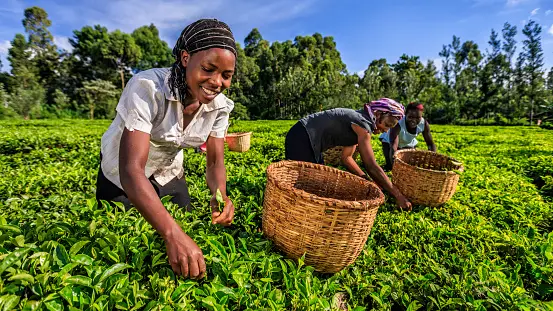Agricultural grants are financial allocations provided by governments, institutions, or organizations to support individuals, farmers, or communities involved in agriculture.
These grants aim to enhance sustainable farming practices, improve food security, and promote innovation in the agricultural sector. By offering funding for equipment, research, or infrastructure development, agricultural grants play a pivotal role in fostering a resilient and thriving agricultural industry.
These initiatives not only empower farmers but also contribute to the overall growth and sustainability of agricultural practices, ensuring a robust and resilient food production system.
The Importance of Agricultural Grants
1. Empowering Farmers:
Agricultural grants empower farmers by providing financial support for essential resources like seeds, fertilizers, and equipment. This enables them to invest in their farms, enhance productivity, and lift themselves out of poverty.
2. Innovation and Research:
Funding from agricultural grants fuels research and development in agriculture. It supports projects that explore innovative farming methods, crop varieties, and technologies, fostering a culture of continuous improvement and adaptation to changing conditions.
3. Sustainable Practices:
Grants encourage the adoption of sustainable agricultural practices. By supporting initiatives promoting soil conservation, water efficiency, and biodiversity, these grants contribute to long-term environmental health and resilience in the face of climate change.
4. Infrastructure Development:
Financial assistance from grants aids in the development of essential agricultural infrastructure such as irrigation systems, storage facilities, and transportation networks. This not only improves efficiency in production but also helps farmers reach broader markets.
5. Food Security:
Agricultural grants play a pivotal role in ensuring food security by supporting initiatives that enhance crop yields and promote stable food production. This is particularly crucial in regions prone to food shortages or facing challenges like droughts and other climate-related issues.
6. Rural Economic Growth:
Investing in agriculture stimulates economic growth in rural areas. By providing grants to farmers and agricultural enterprises, there is a ripple effect that boosts local economies, creating jobs and improving living standards.
7. Risk Mitigation:
Agriculture is inherently vulnerable to various risks, including weather fluctuations and market uncertainties. Grants offer a safety net, helping farmers withstand unforeseen challenges and fostering resilience in the agricultural community.
8. Capacity Building:
Agricultural grants often include provisions for training and capacity-building programs. These initiatives equip farmers with the knowledge and skills necessary to adopt modern farming practices, manage resources efficiently, and navigate dynamic market conditions.
9. Biodiversity Conservation:
Grants support projects that promote biodiversity conservation within agricultural landscapes. This includes preserving native plant and animal species, creating balanced ecosystems, and minimizing the environmental impact of farming activities.
10. Global Economic Stability:
A robust and sustainable agricultural sector contributes to global economic stability. By investing in agriculture, governments and organizations can address issues like poverty, malnutrition, and social unrest, fostering a more secure and interconnected world.
List of Foundations Awarding Agricultural Grants
1. Bill & Melinda Gates Foundation:
Focus: Global agricultural development, sustainable practices, and empowering smallholder farmers. They aim to enhance productivity and improve livelihoods in developing regions.
2. The Rockefeller Foundation:
Focus: Sustainable agriculture, resilience in the face of climate change, and innovation in food systems. Their initiatives often target improving access to resources for farmers.
3. Syngenta Foundation for Sustainable Agriculture:
Focus: Supporting small-scale farmers, fostering innovation in agriculture, and promoting sustainable practices. They work towards improving farm productivity and resilience.
4. African Agricultural Technology Foundation (AATF):
Focus: Technology transfer, crop improvement, and facilitating access to agricultural innovations in Africa. AATF aims to enhance food security and alleviate poverty.
5. United States Department of Agriculture (USDA):
Focus: Various grant programs supporting American farmers, rural development, and research in agriculture. Initiatives cover a wide range from crop insurance to conservation efforts.
6. Global Agriculture and Food Security Program (GAFSP):
Focus: Addressing food security challenges in developing countries by providing grants to support agricultural projects that benefit smallholder farmers and vulnerable populations.
7. National Institute of Food and Agriculture (NIFA):
Focus: Research and education grants in the United States, covering areas such as sustainable agriculture, crop science, and improving food safety.
8. The International Fund for Agricultural Development (IFAD):
Focus: Investing in rural development projects, empowering smallholder farmers, and promoting sustainable agricultural practices in developing countries.
9. The World Bank – Agriculture Global Practice:
Focus: Large-scale projects supporting agriculture and rural development globally, with a focus on increasing productivity and promoting inclusive and sustainable growth.
10. Heifer International:
Focus: Livelihood development, poverty alleviation, and sustainable agriculture. They provide grants to projects that empower communities through livestock and agricultural training.
11. The Global Environmental Facility (GEF):
Focus: Supporting projects that integrate environmental sustainability with agriculture. GEF funds initiatives that promote biodiversity conservation and climate-smart agricultural practices.
12. Commonwealth Foundation:
Focus: Strengthening civil society, promoting sustainable development, and supporting initiatives that enhance agricultural practices across Commonwealth countries.
13. International Development Research Centre (IDRC):
Focus: Funding research to address global challenges, including agricultural innovation, food security, and sustainable development in developing countries.
14. Olam International:
Focus: The Olam Prize for Innovation in Food Security recognizes and supports innovative agricultural projects that address food security challenges.
15. European Agricultural Fund for Rural Development (EAFRD):
Focus: Supporting rural development and agricultural projects in European Union member states. Grants cover areas such as modernization, environmental sustainability, and rural diversification.
16. The Howard G. Buffett Foundation:
Focus: Investing in global food security, sustainable agricultural practices, and addressing challenges faced by smallholder farmers. They support projects that enhance food production and promote resilience.
17. Global Fund for Women: Agriculture and Food Sovereignty Program:
Focus: Empowering women in agriculture, promoting food sovereignty, and supporting initiatives that address gender inequalities within the agricultural sector.
18. The Japan International Cooperation Agency (JICA):
Focus: Providing technical assistance and grants for agricultural development projects in developing countries. JICA supports initiatives to improve productivity, infrastructure, and sustainable farming practices.
19. International Fund for Agricultural Development (IFAD) – Adaptation for Smallholder Agriculture Programme (ASAP):
Focus: Grants specifically designed to help smallholder farmers adapt to climate change. ASAP supports projects enhancing resilience and sustainable practices.
20. The Australian Centre for International Agricultural Research (ACIAR):
Focus: Collaborative agricultural research between Australia and partner countries in the Asia-Pacific region. ACIAR funds projects aimed at improving agricultural productivity, food security, and rural livelihoods.
Engaging with these diverse foundations provides a comprehensive view of the global effort to support agriculture. Each plays a crucial role in addressing unique challenges and contributing to the overall development and sustainability of the agricultural sector.
How to Apply for Agricultural Grants
1. Research Available Grants:
Begin by researching and identifying agricultural grants that align with your specific needs and project goals. Consider factors such as grant focus areas, eligibility criteria, and application deadlines.
2. Understand Eligibility Requirements:
Thoroughly review the eligibility criteria outlined by the granting organization. Ensure that your project or initiative complies with these requirements, including geographical restrictions, project scale, and target beneficiaries.
3. Develop a Detailed Project Proposal:
Craft a comprehensive project proposal that clearly outlines the goals, objectives, and expected outcomes of your agricultural project. Include a detailed budget, timeline, and a solid plan for sustainability.
4. Demonstrate Impact and Innovation:
Emphasize the positive impact your project will have on the community, environment, or agricultural practices. Highlight any innovative aspects, technologies, or approaches that set your proposal apart.
5. Align with Granting Organization’s Mission:
Tailor your proposal to align with the mission and priorities of the granting organization. Showcase how your project contributes to their overarching goals and objectives, increasing the likelihood of approval.
6. Prepare Budget and Financial Documents:
Develop a detailed and realistic budget for your project, including all necessary expenses. Be transparent about your financial needs, and provide supporting documents such as quotes and estimates.
7. Engage Stakeholders and Partners:
Demonstrate collaboration by engaging with local communities, stakeholders, or potential project partners. Highlighting these connections strengthens your proposal and emphasizes the project’s community support.
8. Adhere to Application Guidelines:
Follow the specific guidelines outlined in the grant application. Pay attention to formatting, submission requirements, and any additional documents or supporting materials that may be requested.
9. Seek Professional Guidance:
Consider seeking assistance from agricultural extension services, consultants, or professionals experienced in grant applications. They can provide valuable insights, review your proposal, and ensure it meets industry standards.
10. Review and Revise:
Before submission, carefully review your application for clarity, coherence, and completeness. Ensure that all required documents are attached and that your proposal effectively communicates the significance of your project.
11. Submit on Time:
Be punctual in submitting your application before the deadline. Late submissions are typically not accepted, and meeting deadlines reflects your commitment and professionalism.
12. Follow Up:
After submission, follow up with the granting organization if possible. Seek feedback on your proposal, and use any provided insights to improve future applications. Building relationships with grant providers can be beneficial for future opportunities.
13. Be Prepared for Evaluation:
Understand that the granting organization will evaluate applications based on predetermined criteria. Be ready to provide additional information or clarification if requested during the evaluation process.
14. Celebrate Success or Learn from Rejections:
If your application is successful, celebrate the achievement and adhere to the grant terms and conditions. If unsuccessful, seek feedback, learn from the experience, and consider refining your proposal for future opportunities.
The Impact of Agricultural Grants
The impact of agricultural grants extends far beyond the immediate financial assistance provided. These grants play a pivotal role in shaping the trajectory of agriculture, fostering sustainable practices, and uplifting communities.
1. Enhanced Productivity and Yield:
Agricultural grants often fund initiatives geared towards improving farming techniques, providing access to modern equipment, and promoting the use of advanced technologies. This leads to increased agricultural productivity and higher crop yields, crucial for addressing global food demand.
2. Empowering Smallholder Farmers:
Smallholder farmers, often the backbone of agricultural communities, benefit significantly from grants. Financial support enables them to invest in resources, access training programs, and adopt innovative practices, ultimately empowering them to break the cycle of poverty.
3. Adoption of Sustainable Practices:
Many agricultural grants emphasize sustainability by supporting projects that promote environmentally friendly practices. This includes conservation farming, organic methods, and water-efficient irrigation systems, contributing to the long-term health of ecosystems.
4. Diversification and Livelihood Improvement:
Grants facilitate agricultural diversification, allowing farmers to explore new crops or livestock that are resilient to changing climate conditions. This not only improves food security but also contributes to the overall economic well-being of farming communities.
5. Technological Advancements:
Funding from agricultural grants drives technological advancements in agriculture. This includes innovations in precision farming, drone technology, and smart agriculture, enhancing efficiency, reducing resource usage, and improving overall farm management.
6. Community Development:
Agricultural grants contribute to the development of rural communities. Infrastructure projects funded by grants, such as irrigation systems, storage facilities, and market access roads, create a positive ripple effect, boosting economic activities and improving the quality of life.
7. Resilience to Climate Change:
Climate-smart agriculture, supported by grants, helps farmers adapt to the impacts of climate change. This includes resilient crop varieties, water management strategies, and disaster preparedness, ensuring a more robust agricultural sector in the face of environmental challenges.
8. Global Food Security:
Agricultural grants contribute significantly to global food security by supporting initiatives that address the root causes of hunger and malnutrition. Improved agricultural practices and increased yields contribute to a more stable and secure global food supply.
9. Educational Opportunities:
Grants often include provisions for education and training programs. This empowers farmers with the knowledge and skills needed to implement best practices, manage resources efficiently, and stay informed about the latest developments in agriculture.
10. Economic Growth and Job Creation:
By supporting agricultural enterprises and small-scale farming initiatives, grants stimulate economic growth and job creation. This is particularly impactful in rural areas, where agriculture is a primary source of employment.
11. Biodiversity Conservation:
Grants that promote sustainable agriculture also contribute to biodiversity conservation. Projects focusing on preserving natural habitats, protecting native species, and minimizing the use of harmful agrochemicals contribute to a healthier and more diverse ecosystem.
12. Crisis Response and Recovery:
Agricultural grants are instrumental in responding to crises such as natural disasters or pandemics. They provide a lifeline for farmers affected by unforeseen events, helping them recover and rebuild their livelihoods.
13. Market Access and Value Chains:
Grants often support initiatives that strengthen market linkages and value chains. This ensures that farmers not only produce more but also have improved access to markets, leading to better prices for their products.
14. Social Equity and Inclusion:
Granting organizations increasingly focus on projects that promote social equity and inclusion. This includes initiatives that empower women in agriculture, support marginalized communities, and ensure fair access to resources.
15. Innovation and Research Advancements:
Agricultural grants fuel research and innovation. They support projects exploring new farming technologies, crop varieties, and methods, contributing to continuous advancements in the agricultural sector.
16. Water and Resource Management:
Many grants address the critical issue of water scarcity by supporting projects focused on efficient water management. This includes the development of water-saving irrigation systems and the promotion of sustainable water practices.
17. Food Quality and Safety:
Grants contribute to improving food quality and safety standards. They support initiatives that implement best practices in food handling, storage, and processing, ensuring that consumers have access to safe and nutritious food.
18. Public Health Benefits:
By promoting sustainable farming practices, agricultural grants indirectly contribute to public health. Reduced use of harmful pesticides and chemicals in agriculture leads to cleaner air, water, and soil, benefiting the overall well-being of communities.
19. Cross-Sector Collaboration:
Agricultural grants often encourage collaboration between different sectors, including government agencies, NGOs, and private enterprises. This cross-sectoral approach amplifies the impact of initiatives and promotes holistic solutions to agricultural challenges.
20. Long-term Economic and Environmental Sustainability:
Perhaps most significantly, the impact of agricultural grants is seen in the establishment of a foundation for long-term economic and environmental sustainability. By addressing systemic issues and fostering resilience, grants contribute to a more sustainable future for agriculture.
Tips for Writing a Successful Grant Proposal for Agricultural Grants
1. Understand the Granting Organization:
Begin by thoroughly researching the granting organization. Understand their mission, priorities, and the specific focus areas of the agricultural grant. Tailor your proposal to align seamlessly with their objectives.
2. Clearly Define Your Project Objectives:
Clearly articulate the goals and objectives of your agricultural project. Be specific about what you aim to achieve, ensuring that the granting organization can easily grasp the impact and significance of your proposal.
3. Know Your Audience:
Consider the audience reviewing your proposal. Whether it’s a government agency, foundation, or private entity, tailor your language and presentation to resonate with their values and expectations.
4. Provide a Detailed Project Plan:
Develop a comprehensive project plan that outlines each step of your agricultural initiative. Include a realistic timeline, key milestones, and a detailed budget. This showcases your strategic thinking and enhances the credibility of your proposal.
5. Highlight Innovation and Uniqueness:
Emphasize any innovative aspects of your project. Whether it’s the use of advanced technologies, unique farming methods, or novel approaches, showcasing innovation can make your proposal stand out.
6. Demonstrate Sustainability:
Address the long-term sustainability of your project. Outline how it will continue to benefit the community or environment beyond the grant period. This demonstrates foresight and a commitment to lasting impact.
7. Emphasize Community Engagement:
Highlight community involvement and support for your project. This could include partnerships with local organizations, engagement with stakeholders, or involvement of the target community. Showcase a collaborative approach.
8. Clearly Articulate Expected Outcomes:
Clearly state the expected outcomes and impact of your agricultural project. Whether it’s increased crop yields, improved livelihoods, or environmental benefits, provide measurable indicators that the granting organization can track.
9. Address Potential Challenges:
Acknowledge potential challenges and risks associated with your project. Demonstrate a proactive approach by outlining how you plan to mitigate these challenges. This shows that you have considered the project from all angles.
10. Quantify the Impact:
Use data and statistics to quantify the potential impact of your project. Whether it’s the number of beneficiaries, increased production, or environmental benefits, numerical evidence adds credibility to your proposal.
11. Provide Evidence of Need:
Clearly articulate the need for your project. Use data, research findings, or local context to illustrate why your agricultural initiative is essential. This helps the granting organization understand the urgency and relevance of your proposal.
12. Tailor Your Language to Non-experts:
Craft your proposal using language that is accessible to non-experts. Avoid jargon and technical terms that may be unfamiliar to those not deeply involved in agriculture. Clearly explain concepts to ensure broader understanding.
13. Create a Compelling Executive Summary:
Begin your proposal with a compelling executive summary. This concise section should encapsulate the key elements of your project, its significance, and why it merits funding. It acts as a snapshot that draws the reader in.
14. Use Visuals Effectively:
Incorporate visuals such as charts, graphs, or images to illustrate key points. Visuals not only break up text but also provide a quick and engaging way for reviewers to grasp complex information.
15. Seek Feedback Before Submission:
Share your proposal with peers, mentors, or experts in agriculture for feedback. Constructive input can help refine your proposal, ensuring that it is clear, compelling, and addresses any potential weaknesses.
16. Follow Application Guidelines:
Adhere closely to the application guidelines provided by the granting organization. Failure to follow instructions may result in disqualification. Pay attention to formatting, document requirements, and submission deadlines.
17. Tell a Compelling Story:
Weave a narrative that captivates the reader. Share stories of individuals or communities impacted by your project. A compelling narrative can evoke emotions and make your proposal memorable.
18. Showcase Past Successes:
If applicable, highlight any past successes or achievements related to agricultural projects. This demonstrates your track record and ability to effectively implement initiatives.
19. Demonstrate Capacity to Evaluate and Learn:
Outline your approach to project evaluation. Showcase your capacity to measure and learn from project outcomes. This demonstrates accountability and a commitment to continuous improvement.
20. Express Gratitude and Commitment:
Conclude your proposal by expressing gratitude for the opportunity and reiterating your commitment to the goals of the granting organization. Convey a sense of enthusiasm and dedication to seeing the project through.
Conclusion:
Agricultural grants stand as powerful catalysts for positive change within the agricultural sector. These financial investments extend far beyond mere monetary support, weaving a tapestry of sustainable practices, innovation, and community empowerment. As we navigate the intricate landscape of global agriculture, these grants emerge as beacons of hope, fostering resilience, addressing challenges, and contributing to the overall well-being of our planet.
From empowering smallholder farmers to promoting technological advancements and sustainable practices, agricultural grants play a pivotal role in shaping the future of food production. The impact reverberates through communities, driving economic growth, enhancing food security, and creating a foundation for long-term environmental sustainability.
As we reflect on the multitude of initiatives supported by agricultural grants, it becomes evident that they are not just financial transactions; they represent a shared commitment to a flourishing and resilient agricultural landscape. The collaboration between granting organizations, farmers, and communities reflects a collective effort to overcome challenges, embrace innovation, and build a future where agriculture thrives in harmony with the environment and nourishes societies.
In the ever-evolving world of agriculture, the importance of these grants cannot be overstated. They embody the spirit of progress, enabling us to tackle complex issues such as climate change, food insecurity, and rural poverty. As we move forward, let us recognize and celebrate the transformative power of agricultural grants, acknowledging their role in shaping a sustainable, equitable, and bountiful future for generations to come.
Recommended Books for Enhancing Grant Writing Skills
To further enhance your grant writing skills and stay on top of these trends, consider diving into some insightful literature.
Here are a few recommended books:
- The Ultimate Guide to Federal Grant Applications: Techniques for Success – This book is a must-read for anyone looking to navigate the complex world of federal grant applications. It offers practical techniques, insider tips, and a comprehensive understanding of what it takes to create successful federal grant applications.
- Advanced Grant Writing for Nonprofits : Focuses on sophisticated techniques for experienced grant writers. It delves into complex aspects of proposal development, offering strategies for dealing with competitive grant environments and large funding bodies.
- Mastering Grant Writing: A Nonprofit’s Guide to Effective Proposal Development and Submission: This book serves as a comprehensive guide, covering the entire process of grant writing. It includes tips on understanding funders’ perspectives, crafting compelling narratives, and the nuances of proposal submission.
- Becoming the Grant Guru: Freelancer’s Guide to Success : Tailored for freelance grant writers, this book provides insights into building a successful career in grant writing. It includes strategies for finding clients, managing projects, and maximizing the impact of grant proposals.
- The Small Business’s Guide to Winning Grants : This resource is particularly useful for small businesses looking to secure grants. It offers practical advice on identifying suitable grant opportunities, understanding the requirements of small business grants, and crafting winning proposals.
- Grant Readiness Guide: Preparing to Triumph in Funding Opportunities : A comprehensive resource for organizations at various stages of grant preparedness. It provides a roadmap for developing organizational capacity, aligning projects with funders’ goals, and creating compelling applications.
- Her Capital: Unlocking Women’s Small Business Grants: Specifically designed for women entrepreneurs, this book offers guidance on navigating the landscape of small business grants for women. It includes insights into grant sources, application strategies, and tips for leveraging grants to grow a business.
Unlock Your Grant Success!
Join our email list now for exclusive grant-writing tips and unique grant opportunities delivered straight to your inbox. Click here to Subscribe. Don’t miss out!






